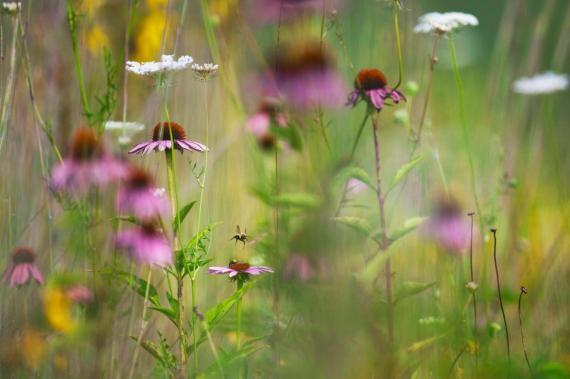Pollinators have been making news. We depend on the numerous insects, birds, and mammals for the majority of the food we eat every day. These creatures serve a vital part of the ecosystem, but they’re disappearing fast.
In North America, most of our pollinators are of the insect variety – native bees, honeybees (and yes, honeybees are not native to the United States), beetles, flies, butterflies, etc. While much of the news stories have been focused on the large-scale problem and several large-scale solutions, there are several things you at home can do to help out pollinators in your very own backyard. No matter the size, any help at all is useful. Think of it this way, if everyone in your neighborhood planted one small plot of native wildflowers, or put one bee block (aka bee hotel), all of those small things would add up to a LOT of good habitat for our little insect friends.
National Geographic has put together a list of 9 simple things you can do at home. Bonus: many of these things help out more than just the pollinators.
9 Ways You Can Help Bees and Other Pollinators At Home
This week the White House released new strategies to boost the insects so crucial to our food supply. Here’s how you can do your part to support pollinators at home.
By Jennifer S. Holland, National Geographic
If you like to eat, you can thank insects—in particular, pollinators such as honeybees, which provide much of the U.S. food supply. Sadly, pollinators in the United States have been in crisis for more than a decade.
Beekeepers continue to report major hive losses each year, while many native bees and other pollinating insects are likely in steep decline—for a host of reasons. This week the White House weighed in on how to make things better, releasing a new National Strategy to Promote the Health of Honey Bees and Other Pollinators. (Related: “Obama Unveils Plan to Reverse Alarming Decline of Honeybees.”)
Meanwhile, are there things the rest of us can do to help relieve pollinators’ plight?
Absolutely, says Ed Spevak, curator of invertebrates and director of the Center for Native Pollinator Conservation at the St. Louis Zoo in Missouri. He talked to National Geographic about the best ways regular folks with lawns and gardens, wherever they live, can help the birds and the bees (and the butterflies).
Go Native
Choose native plants in a variety of shapes and colors to encourage diversity. Remember that native wildflowers will be better adapted to your climate than exotics. And one size doesn’t fit all: There are over 4,000 bee species in North America (some 20,000 worldwide) ranging from two millimeters to an inch (2.5 centimeters) long, so blossoms should vary in species and size, too. (Read “Quest for a Superbee” in National Geographic magazine.)
Keep It Blooming
Among your native plants, make sure something is blooming each season (spring, summer, and fall). Some bee species are active all year, others only in April and May, still others in July and August, and all need to feed regardless of the date.
Save the Queen
Newly emerging bumblebee queens need spring-blooming flowers, shrubs, and trees. Bumblebees, unlike, honeybees, have an annual cycle. New queens are born in the fall, and after breeding they find a place to hibernate for the winter. When the insects emerge in spring, they need nectar and pollen sources—or they can’t start their colonies. (See beautiful, intimate portraits of bees.)
Plant Milkweed
Adding milkweed to your garden provides food for monarch butterfly caterpillars, but don’t forget nectar sources for the adults, such as flowers that bloom in late summer. Adults get especially hungry in the fall as they head south to their overwintering sites in Mexico.
Save Money on Mulch
Leave a little bare ground. Most species of bees are solitary, and some 70 percent of them dig a nest in the ground to raise their young—something they can’t do if mulch is in the way (Read more about creating a sustainable home and garden.)

Bret Adee opens a beehive in Lost Hills, California, home to Adee Honey Farms, the world’s largest commercial beekeeping operation.
Photograph by Anand Varma, National Geographic
Offer Bee Real Estate
Install a bee block or bee hotel, which are available online or at some garden stores. (Or, build one yourself.) You could also drill holes of varying sizes in a dead tree that’s still standing (if beetles haven’t done it for you). This offers habitat to the many bee species that nest in pre-existing holes.
Make a Border
By bordering your fruits and vegetables with native flowers, you’ll improve pollination of your crops and also support bees when the crops stop blooming. It will also attract and support other pollinators such as wasps and hover flies that control crop pests. (See National Geographic’s list of the world’s top 10 gardens.)
Go Easy on the Chemicals
Pesticides can affect more than pests. Adding plants that draw natural pest-eaters (see above) and “companion planting”—including plants that naturally repel pests, such as garlic for aphids and basil for tomatoes—are good strategies to reduce chemical needs, according to organic gardeners. Maintaining healthy soil to keep plants’ immune systems strong can also help.
Get Involved
Learn more about organizations that support pollinators and their habitats, such as Pollinator Partnership or the Honeybee Health Coalition. You can also participate in citizen-science programs for pollinators such as Bumble Bee Watch (Xerces Society), The Great Sunflower Project (San Francisco State University), Fourth of July Butterfly Count (North American Butterfly Association), and the Monarch Larva Monitoring Project (Monarch Watch).





